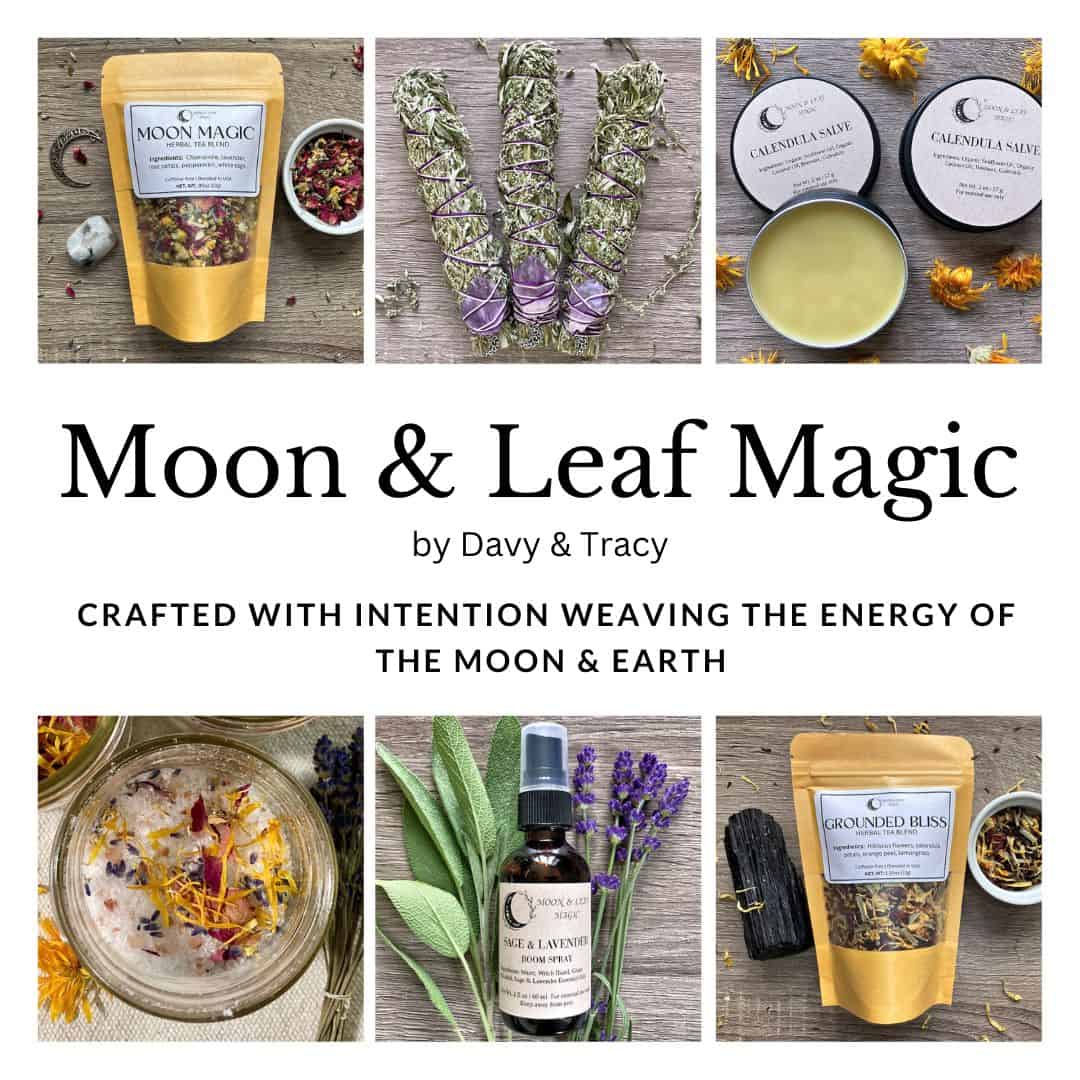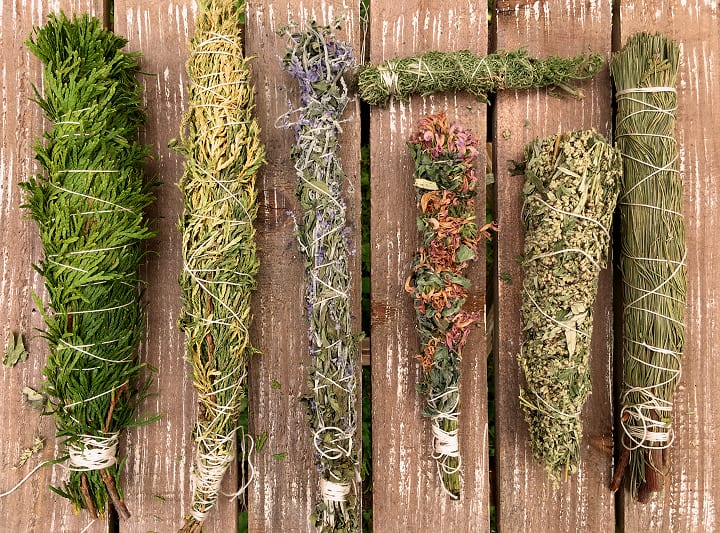
Smudging and the use of smudge sticks have become quite popular in recent years, with white sage being the most popular herb used.
However, most people don’t know that there are MANY more herbs that you can use beside the ever-popular white sage and cedar.
In fact, most people have access to dozens of plants in their own backyard that can be used to make smudge sticks.
This guide will teach you everything you need to know to start making your own wild-crafted smudge sticks with plants that grow around you!
What are smudge sticks and what is smudging?
What most of us refer to as smudge sticks are simply a bundle of dried herbs that have been wrapped together to form a sort of wand. You then light the tip, blow out the flame, and allow the fragrant smoke to waft through a space.
The term “smudging” refers to a distinctly Native American ceremonial or ritual practice that involves burning herbs to purify and cleanse a space or other people.
However, simply lighting a bundle of herbs and wafting the smoke over yourself, someone else, or within a space isn’t necessarily “smudging”. Sadly, the term has become commodified and appropriated by non-Native people.
However, burning herbs and using aromatic smoke in ritual has been practiced since ancient times, and spans many different cultures worldwide.
I no longer use the term “smudging” to describe wafting aromatic smoke since I am not Native American, and have no cultural claim to the practice.
I call my ritual “smoke cleansing” and refer to my “smudge sticks” as “smoke wands”. I also recognize that the ritual I perform is not actually “smudging” since I am not attempting to replicate a specific Native American ritual.
While some may disagree, I use the term “smudge stick” in this article simply because it has become a commonly used term for these herb bundles – and that’s the term that most people search for when they find this article.
Why Use Smudge Sticks?
Using smudge sticks, or smoke wands, as I prefer to call them, is one of my favorite ways to connect to plants and herbs in my nature-focused, spiritual practice.
I burn sage or cedar to ritually purify my sacred space, a tarot deck, or crystal. I also burn sage when I am feeling stressed, anxious, or overwhelmed.
The aroma and sight of the smoke swirling around me has an almost magical effect at easing tension and enhancing peaceful energy.
I light a smudge stick when I feel that my energy, or the energy of a space, needs shifting. I burn aromatic herbs during moon rituals, seasonal sabbats, or during meditation.
Each plant has its own properties, so there are many reasons to make a variety of smudge sticks.
For example, white sage is often used to cleanse and purify.
Cedar is used to boost positive energy.
Mugwort is used for dream work and divination.
Lavender is used for calming and de-stressing.
The list goes on and on.
How To Use Smudge Sticks
To burn a smudge stick, simply light one end with a match, lighter, or candle.
You may need to hold the bundle in the flame for a few seconds for it to catch. Once you see flame, wave the smudge stick or gently blow the flame out.
As smoke wafts from the lit end of the stick, wave it around a space, or over/under an object that you want to purify or charge.
You may need to relight the smudge stick several times. Some herbs (like catmint or Russian sage) will burn until the stick is completely used up, while cedar and many others need to be re-lit frequently during use.
I like to have a heat-resistant container nearby when I use smudge sticks. Traditionally, an abalone shell is used, but I prefer to use my 4-inch mini cast-iron cauldron.
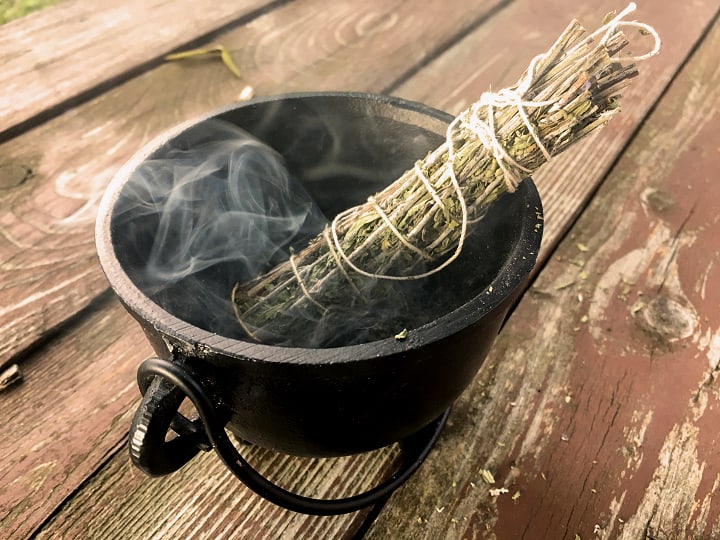
Step-By-Step Smudge Stick Making
Okay, so you want to make your own smudge sticks.
Below is a step-by step guide on how to make them, storage tips, and a guide to 10 plants that are probably growing around your home that you can use.
Step 1: Gather The Herbs
The first step is to gather the herbs you want to use to make smudge sticks.
When gathering herbs, it’s important to be ethical about it. Don’t take from private property without permission. Follow rules in local parks about wild-harvesting (most don’t allow it). Only take what you need, and never destroy an entire plant.
Some people ask the plant’s permission before cutting, or they leave a little offering (like seeds, or fertilizer.)
I use a pair of pruning shears (hand shears) to cut what I need.
Any time of year is fine for harvesting evergreens like cedar and pine. For most everything else, I find that the best time to harvest is when it is in bloom, or mid-late summer.
Step 2: Pre-Dry
Before you can wrap most herbs into a smudge stick, hang them up to dry slightly for a day or two.
For example, I let Russian sage dry for 24 hours before wrapping it.
You want the herbs to just start drying, but not be crispy. There should be enough moisture left to wrap them up without pieces crumbling off.
Typically, herbs are ready within 24-48 hours after harvest.
The exception is evergreens like pine, cedar, cypress, and juniper, which can be wrapped up into a smudge stick immediately.
Be sure to wrap the string extra tight when working with evergreens as the smudge stick will shrink in diameter slightly as they dry.
Step 3: Bind Them Up
Tying up smudge sticks are the trickiest part. Here’s how to do it:
Step 1: Tie the bundle together about an inch from the base. Make sure it’s a tight, double knot. Be sure to leave a couple inches of string at the base. You’ll need this extra couple inches of string later.
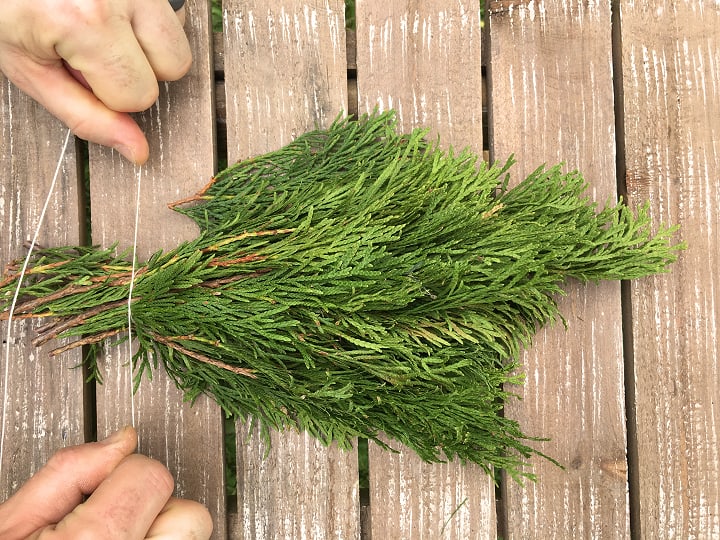
I use natural cotton embroidery thread for this. You can use any natural, untreated thread or string that is strong enough to pull tightly around a bundle of herbs.
Step 2: Wrap the string tightly around the base several times.

Step 3: Tightly wrap the string up the bundle of herbs, moving up in a spiral being sure to keep all of the plant material going in the same direction.
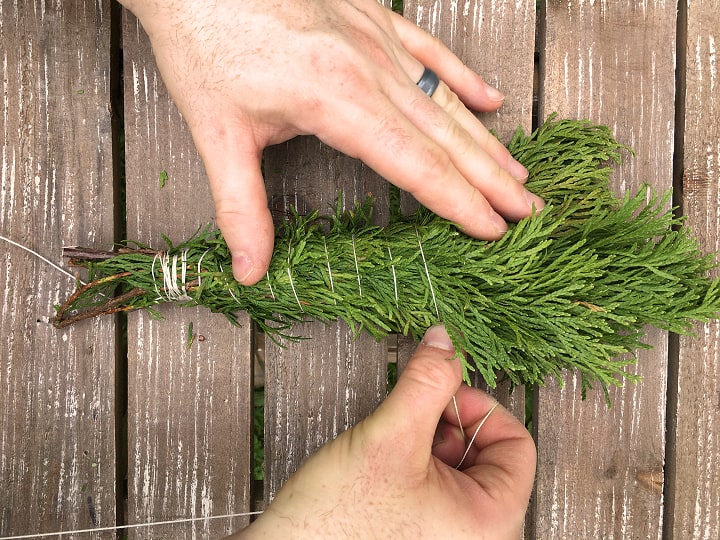
Step 4: Wrap the string around the top a couple times, and then work your way back down toward the base of the smudge stick.

Note: Sometimes, the smudge stick may become curved. If this happens, simply straighten it out and adjust the wrapping to keep it straight.
Step 5: Wrap the string around the base a few more times.
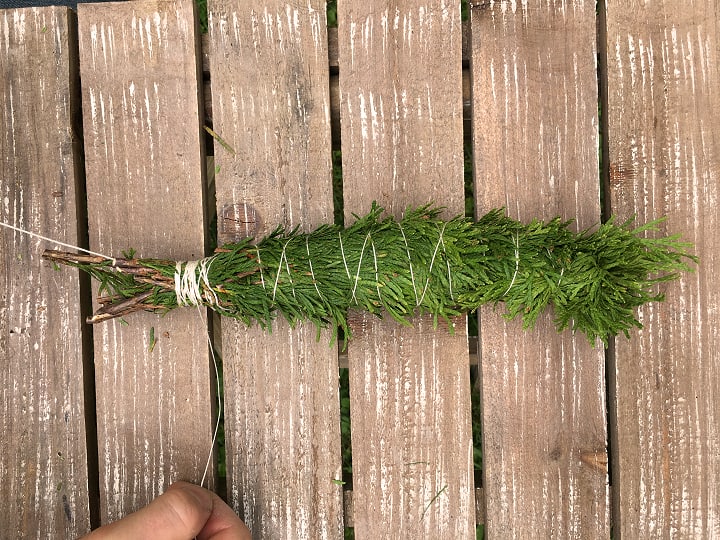
Step 6: Tightly tie the string together (the piece you have been wrapping around the smudge stick to the couple of inches of string you left when you tied the first knot.) Make sure it’s a tight, double knot.
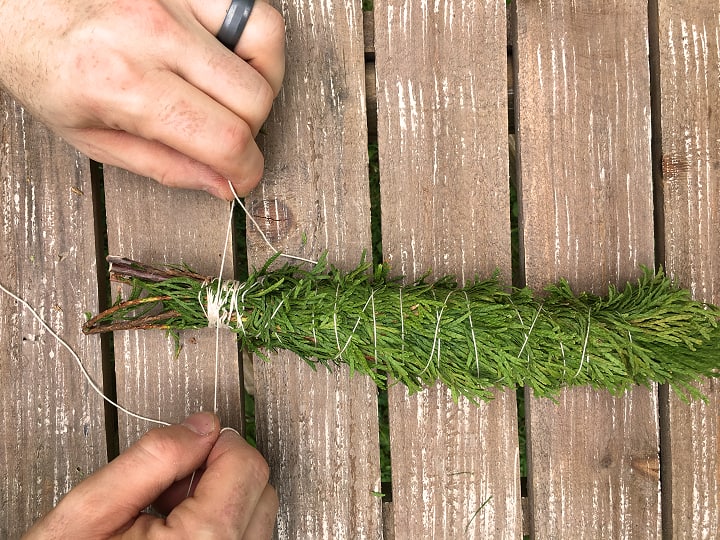
Step 7 (Optional): Trim both ends to tidy up the smudge stick.
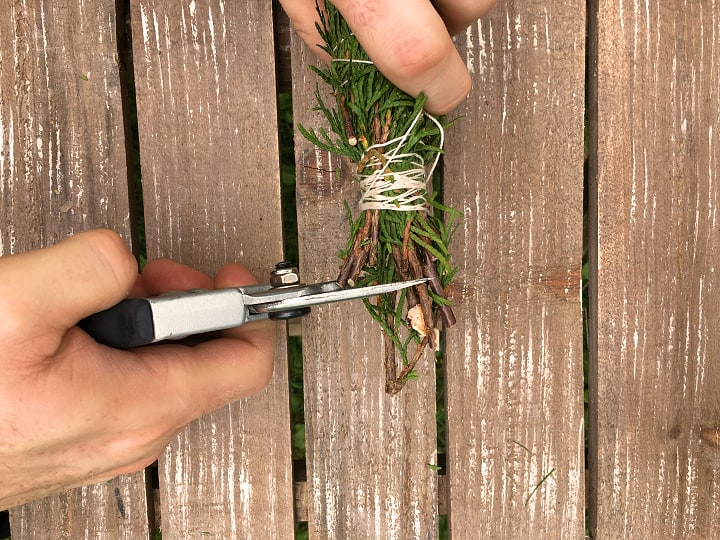
Step 4: Dry Completely
After you wrap your smudge sticks, hang them back up to dry completely.
Be sure to hang your drying herbs/smudge sticks in a dry, shaded, sheltered spot – NOT in direct sunlight or where high humidity/moisture is present – otherwise they’ll get moldy.
This process may take as little as a week or two, or as long as 8-10 weeks (especially if working with cedar, pine, cypress, and juniper).
How To Store Your Smudge Sticks
Perhaps the best way to store smudge sticks (after they have been thoroughly dried) is to place them in an air-tight, glass mason jar out of direct sunlight.
Another option is to use gallon-sized plastic bags to protect them from moisture.
I prefer to keep smudge sticks separate from each other. I will store all my cedar smudges together, but prefer not to put a variety of smudge sticks together as the aromas tend to blend with undesirable results.
If space is limited, you can keep similar smudges together. For example, I might place cedar, juniper, cypress, and pine smudges together, and then Russian sage and catmint together.
I recommend using up your smudges within one year.
Plants To Use For Smudging
Just about any plant can be used for making smudge sticks, but some just work (and smell) better than most.
Here are the plants I use for my homemade smudge sticks:
1) Sage (Salvia sp.)
Sage is one of the most popular smudge stick materials. The common name itself is associated with wisdom and spirituality.
The most common type of sage used in smudge sticks (especially the ones that are commercially available) is white sage – Salvia apiana.
Unfortunately, white sage has become threatened from over-harvesting and rampant, illegal poaching. Most white sage found in stores and sold online is sourced by poaching.
Because of this, I highly recommend that you use alternate herbs like the ones I will list below unless you grow the plant yourself, or you can confirm that it comes from a sustainable source (and don’t just go off of labels as there is no oversight on labels that might claim sustainability.)
I grow my own white sage, or I source it directly from Native American artisans who sell it, and then use it sparingly. Burn one leaf at a time, as there is absolutely no need to light an entire bundle.
You can absolutely use common kitchen sage (salvia officinalis) as well.
Symbolism: Purification, cleansing, wisdom.
Harvest: Harvest kitchen sage anytime, or wait until it flowers to incorporate the blossoms into the smudge.
2) Cedar/Arborvitae (Thuja sp.)
Cedar is, perhaps, the second most commonly used smudge.
One of the most common cedars are the ubiquitous landscaping tree, the Arborvitae, which means “Tree of Life”.
Cedar is considered a sacred plant across many cultures.
The scent is a wonderful, sweet woody smell, and cedar wood is a good alternative to palo santo wood.
Symbolism: Cedar is said to cleanse and purify, while boosting positive energy in a space.
Harvest: Any time of year is okay for cedar, but I typically gather mine in mid-late summer.
Smudge Tips: Unlike some other smudging herbs, cedar won’t stay lit. I simply use a tealight candle and hold my cedar smudge stick over it until it produces smoke.
Be sure to let a cedar smudge stick dry for at least 6-8 weeks before use.
3) Mugwort/Croneswort (Artemisia vulgaris)
Mugwort is one of my favorite herbs. I love the aroma of the leaves, and it makes a great smudge stick.
Mugwort is often used in dreamwork and divination, but can also be used to purify and cleanse. Some magical practitioners prefer to call this plant “Croneswort” or “Dreamwort”.
Symbolism: Dreaming, purification, wisdom, divination.
Harvest: Just before the buds open – late summer, early autumn.
Smudge Tips: I prefer to burn mugwort outdoors, as I find that the smell can be strong and lingering when burned in small spaces. With mugwort, a little bit goes a long way.
Be sure to incorporate the floral stalks into the smudge stick for the best aroma.
Learn more about working with mugwort here.
4) Juniper (Juniperus sp.)
Juniper is another evergreen that is great to use in smudge sticks. It’s a common landscape shrub and tree, so chances are, you might have a juniper growing around your home.
Symbolims: Abundance, protection home and property.
Harvest: Anytime. Late summer if you want to include the “berries” in the smudge sticks.
Smudge Tips: A juniper smudge stick can take up to 6-8 weeks to fully dry before it can be used.
5) Pine (Pinus sp.)
Pine has a sweet, pine smell when burned and produces a lot of smoke due to the resins in the twigs.
Symbolism: White pine (Pinus strobus) – Peace, releasing grudges, prosperity; Black pine (Pinus nigra): Protection, good fortune, prosperity.
Harvest: Anytime.
Smudge Tips: I find pine to be tricky to get started. That’s why I usually use a tea light to relight it. However, once I get a pine smudge stick going, it smokes well without needing to be re-lit.
A pine smudge stick can take 6 weeks or so to fully dry before it can be used.
6) Cypress
Cypress is another evergreen that is great to make into a smudge stick.
Symbolism: Cypress is associated with death and the underworld/afterlife, so it’s a good plant to use when letting go, releasing, or doing any ancestor work. It’s a great smudge stick to use at Samhain/Halloween.
Harvest: Anytime.
Smudge Tips: A cypress smudge stick can take up to 6 weeks to fully dry before use.
7) Russian Sage (Perovskia atriplicifolia)
Russian sage is one of my absolute favorite perennials in my pollinator garden. It is also one of my absolute favorite smudging herbs.
Russian sage has a wonderful musky/minty smell, and once a dried smudge stick is lit, it burns until you either put it out or the smudge stick is used up.
Symbolism: Wisdom, knowledge, resilience.
Harvest: When in bloom – typically mid-late summer.
Smudge Tips: Russian sage can get a bit sticky when you work with it, so wash your hands well with soap afterward.
8) Catmint (Nepeta sp.)
Catmint is another common garden plant that makes a wonderful smelling smudge stick, and is super easy to burn.
It is related to catnip (also in the genus Nepeta), which can also be used in a smudge.
Symbolism: Affection, rejuvenation.
Harvest: When in bloom – typically late-spring.
9) Yarrow (Achillea millefolium)
According to myth, the Trojan War hero, Achilles, was taught to use yarrow to treat his soldier’s battle wounds. Yarrow was an important healing herb for soldiers in ancient times.
Yarrow has a mild aroma and burns pretty quickly.
Symbolism: Healing, protection.
Harvest: When in bloom – late spring/early summer.
10) Bee Balm/Bergamot (Monarda sp.)
Bee balm (Mondarda) is a fragrant plant in the mint family, and a common perennial flower sold in garden centers. It is native to North America.
Symbolism: Compassion/sympathy.
Harvest: Harvest when in bloom, typically early-mid summer.
11) Lavender (Lavandula sp.)
Lavender is a popular smudge herb that can be combined with other herbs (like sage) in a smudge stick, or used alone.
Lavender has a distinctive, floral aroma that promotes relaxation and sleep.
Symbolism: Peace, love, harmony.
Harvest: Anytime, or after it blooms in you wish to incorporate the flowers into the smudge stick.

